
Bulletin 26, 1975
Home
Français
Introduction
History
Annual Index
Author &
Subject
Credits
Contact
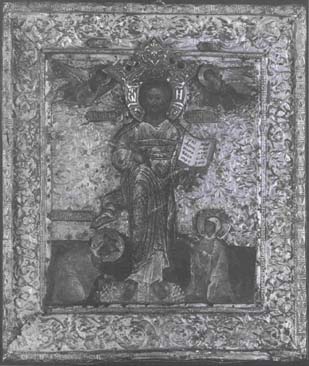
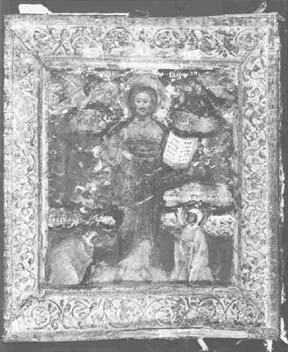
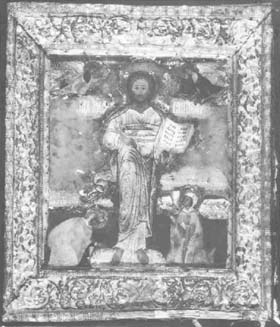
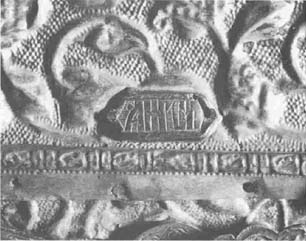
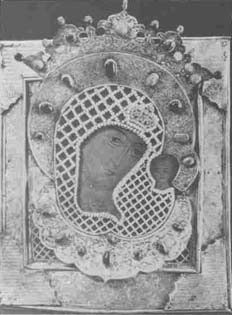
"Christ
with Saints Alexandra and Agatha"
A Russian Icon in the National Gallery
by George Galavaris
Résumé en français
Pages 1 | 2 |
3 | 4 |
5 | 6
| 7
The National Gallery of
Canada recently received a Russian icon which, though modest in
size, is important for a number of reasons. The icon, Christ
with Saints Alexandra and Agatha (fig. I), was bequeathed to the
Gallery by Frederick Hudd of Compton, Surrey, in 1969. It had been
given to him by his colleagues in the Canadian Foreign Service, who
had bought it in Paris. According to a Russian inscription on the
back of the panel, written in ink probably at the turn of the
century, the icon was once in the possession of a Russian count by
the name of Vielgorsky.
The composition is dominated by the figure of Christ standing on a
vermilion cushion decorated in gold. Two female saints are at his
feet and two worshipping angels are in the upper part of the panel.
Christ is depicted frontally and wears a long brown-red chiton ("tunic")
with a clavus (i.e., ornamental band) on his left shoulder and
over it an ample blue himation which falls over the shoulders and
tums around the waist rustling in the air on his right side. Both
the tunic and the himation are marked by very thin gold striations
which also serve as highlights of the drapery. His delicately
painted face is distinguished by a moustache and a soft beard
drawn in thin, parallel lines with two locks falling from the chin.
In his left hand Christ holds the Gospels open to Matthew 11:28
"Come unto me, all ye that labour and are heavy laden, and I
will give you rest." The script is written in black on ivory
white pages. The edges of the book are painted in strong red. With
his right hand, Christ makes a speaking gesture towards the saints
at his feet. The crowned saint at Christ's right foot is identified
by two inscriptions - one on the panel and another on a metal piece
attached to the metal cover of the icon - as Saint Alexandra. There
is no inscribed metal piece identifying the saint on the opposite
side, though the nail-holes indicate that there originally must have
been one. According to an oral tradition whose age and origins I
have not been able to trace, the saint was identified as Mary
Magdalen. But the removal of the metal cover revealed the original
inscription on the panel itself - identifying her as the holy martyr
Agatha.
Alexandra wears a dark blue tunic with sleeves that have wrist-bands
decorated in gold, a red mantle over the tunic, a white
head-covering, and a white and gold crown. Agatha is dressed in a
similar fashion but the colour system is different. Her tunic is
wine red and her mantle is brown. In both figures, white has been
employed for the highlights of the drapery and black has been used
for the contours of the head-covering. Alexandra, extending her
hands towards Christ's feet, bows deeply: she is making a proskynesis
("obeissance") to the Lord Pantocrator. Agatha, though
kneeling, keeps her body upright and, as the position of her hands
show, she addresses Christ. This difference in stance may express
an attempt on the part of the unknown master to vary the composition
or alternatively may be related to the meaning of the scene - we
shall return to this question later. The angels, with hands covered
(a typical sign of reverence and worship), fly towards Christ. The
angel above Alexandra wears a dark blue tunic and a red himation.
The colour system for the tunic and himation of the angel above
Agatha is reversed to avoid monotony and absolute colour
correspondence. The angels' spread-out wings are brown and marked by
gold striations. The highlights are in white and have been applied
in the same manner as those on the drapery of the saints.
The flesh tones are in brown. The modelling is achieved by brown
shades with the lighted parts painted in white. The hair is dark
brown. The contours of Christ's face are stressed by a dark line.
The highlights, applied in blotches, are distributed on the upper
part of the cheeks to stress the cheekbones, above the eyebrows, on
the forehead, and on the tip of the nose. Two white, parallel lines
mark the outside corners of the eye.
An embossed silver sheet with floral motifs covers part of the
background of the icon, but it leaves free the lower part of the
composition which is painted in dark olive green. The metal sheet,
known as a basma, (1) nailed on the panel consists of one major
piece on either side of Christ and additional small pieces cut to
fit the outline of the represented persons. There is a fine metal
frame, also of chased silver, decorated with floral motifs forming
scroll patterns enclosed within borders. The frame is made of four
pieces, placed against cloth backing, with designs that are not
identical - the top and bottom pieces differ from those forming
the sides in the arrangement of the scroll motif and in the shape of
the leaves. Spiral engraved motifs adorn the silver nimbi of the
saints and the angels. In addition to a nimbus with a cross and the
usual letters O w N (He who exists, Ex. 3:14), Christ wears a
rich metal crown decorated with leaves, floral patterns, and two
small crosses in the centre. On the three tips of the crown there
are rings into which precious stones originally must have been
fitted: they are now lost. Other icons that have retained their
original decoration may give us an idea concerning the impression
the crown must once have conveyed (see fig. 5). (2) Small inscribed
pieces, nailed to the basma above or next to the relevant
figure, serve to identify the represented persons (see fig. 4).
For study and conservation purposes the basma was removed
(figs. 2, 3), and the conservation laboratory of the National
Gallery carried out technical investigations - including x-rays
- with the following results. The panel is of soft wood, probably
linden, 2.3 cm thick with two wedges (sponki) which are later
replacements of earlier ones. A partial backing of canvas (povoloka),
forming the underlayer for the painted surface, has been applied
across the upper Dart of the panel from the top to the face of
Christ (approximately 9 cm high) and from the lower edge to the feet
of the kneeling saints (approximately 5 cm high). Normally, cloth
would have been glued to the entire area of the panel on which the
composition was to be painted. But this is not the rule, since partial
use of backing cloth is not altogether unusual. Ordinarily, the
upper and lower parts of a panel crack or break first, once the wood
is warped and the wedges are lost in the course of time. Therefore,
icon painters used cloth to strengthen these sensitive parts of the
panel prior of the levkas (i.e. the layer of powdered alabaster
or gesso, - which receives the painting done in tempera). (3)
Next Page | metal cover of
background
1 |
2 |
3 | 4 | 5 |
6 | 7
Annual Index | Author & Subject | Credits | Contact
This digital collection
was produced under contract to Canada's Digital Collections program,
Industry Canada.
"Digital
Collections Program, Copyright
© National Gallery of
Canada 2001"